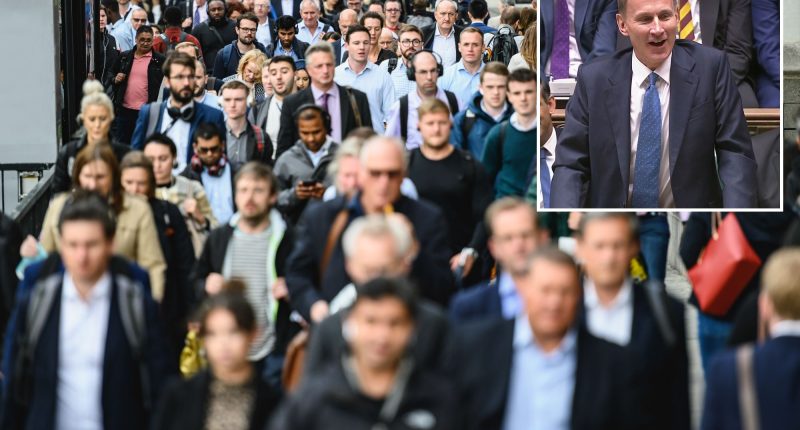FIRST-time buyers and savers are getting extra support under a few changes hidden in Autumn Statement documents.
Chancellor Jeremy Hunt delivered his Autumn Statement this afternoon and set out his plans for taxes and spending.
Mr Hunt vowed to “reduce debt, cut taxes and reward work” as he unveiled a package aimed at saving cash-strapped Brits and turbo-charging the economy.
He slashed National Insurance, boosted Universal Credit benefits and put up the national living wage.
In his speech today, some of the biggest changes Jeremy Hunt announced included:
Read more in money
Below we round up key announcements not mentioned by Mr Hunt, but that can be found in the official documents.
Duty rates for cigarettes
The Chancellor announced that the rate on hand-rolling tobacco will increase by RPI + 12% this year.
However, the Autumn Statment documents have revealed that duty rates on all tobacco products, including packaged cigarettes, will increase continue to increase by RPI +2%.
These changes will take effect from 6pm on November 22 2023 and will be included in the Autumn Finance Bill 2023.
Most read in Money
Taxing tobacco is a huge revenue-raiser for the government, with £10.7billion collected in 2022, which was 1.2% of the total tax taken.
Mr Sunak, now Prime Minister, previously revealed he wants to make Britain “smoke-free” by 2040.
In his speech at the Conservative Party conference this year in Manchester, he announced that children currently under 14 will never be able to legally buy cigarettes in their lifetime.
The hope is that the ever-increasing price of cigs will deter more people from buying them.
Mortgage help for first-time buyers
First-time buyers will get more help to get on the property ladder, the Chancellor has confirmed.
In a move to help budding buyers, the Chancellor has announced that the mortgage guarantee scheme is to be extended.
It’s designed to help households with a smaller deposit purchase their homes.
It was originally announced as part of the 2021 Budget and was set to end on December 31 this year.
That’s now been extended for another 18 months and will end in June 2025.
Under the programme, house buyers need just a £10,000 deposit to be able to afford a £200,000 home.
It enables buyers to take out a mortgage worth 95% loan to value (LTV), meaning only a 5% deposit is needed.
Typically buyers need a 10% deposit and take out a home loan for the remaining 90%.
So far, the scheme has helped over 24,000 households.
How does the scheme work?
Under the scheme, the Government guarantees part of borrowers’ home loans, reducing the risk on the loans.
It means that if the borrower is unable to pay one month, the state will pick up the bill – although it is highly likely there will still be repercussions for borrowers if this happens.
The scheme slashes the minimum amount first-time buyers need to purchase their first homes by half.
For example, a 10% deposit for a £300,00 home is £30,000 but under the programme, buyers would need just £15,000 for a deposit worth 5%.
On a £400,000 house, buyers would need to fork out £20,000 compared to £40,000, or £25,000 instead of £50,000 on a £300,000 home.
The scheme runs for properties worth up to £600,000, which would see the minimum deposit required lowered from £60,000 to £30,000.
But while the scheme will help those struggling to scrape a deposit together, buyers will still need to earn a certain amount to be able to borrow a big enough mortgage.
Lenders will typically lend borrowers up to four or five times their salary.
So to buy a £600,000 house with a 5% deposit, you’d need to have a combined income of a minimum of £135,000 a year.
A major downside of these loans, however, is that the interest rates are often considerably higher than you’d pay with a higher LTV mortgage.
If house prices continue to drop – which is expected next year – this increases the risk of ending up in negative equity.
It means your house is worth less than the mortgage you owe, making it difficult to remortgage at a favourable rate.
You’ll also still be in debt, even if you sell the property.
ISA changes
The government is making changes to simplify ISAs and provide more choice, meaning it will be easier for people to choose the best ISA accounts for their needs and move money between them.
The government will allow multiple subscriptions to ISAs of the same type every year from April 2024.
It will also allow partial transfers of ISA funds in-year between providers from April 2024.
The government will also raise the account opening age for any adult ISAs to 18 from April 2024 – up from 16.
However, it is freezing the ISA annual allowance at £20,000, Junior ISAs at £9,000 a year and Lifetime ISAs at £4,000 a year.
How do ISAs work?
An individual savings account (ISA) is a type of tax-free savings account.
Savers don’t pay tax on any savings interest earned.
The most common types are cash ISAs and stocks and shares ISAs, where your money is invested in the stock market.
Each year, everyone over the age of 16 gets an ISA allowance of £20,000.
This means that they can earn interest on their savings in a bank, building society or another financial provider, without paying tax.
The maximum amount you can put away for the 2022/23 tax year is £20,000.
There is no limit to the number of ISAs you can have, but you can only pay into one of each type in a single tax year.
Help to Save scheme changes
To support low-income households to build savings, the government is also reforming the Help to Save scheme, which aims to encourage low-income workers to save for short-term and long-term term goals and kickstart a lifelong savings habit, through adding a bonus to savings.
The new design will ensure the scheme’s sustainability as a key savings product, encourage take-up and provide the best value for taxpayers.
The new design will be published in due course, alongside the launch of a consultation on the most effective way to deliver it.
How does it work?
Under the scheme, the government gives you 50p for every £1 you save in your account over four years.
You can save between £1 and £50 each calendar month and pay the money in via standing order or bank transfer.
That means if you put the maximum £50 in each month from April 2023 for two years you would get back £600 from the government in total.
Just under 400,000 people have opened a Help to Save account since it launched in September 2018, according to the government’s recent figures.
You can open a Help to Save account if you are:
- Receiving working tax credit
- Are entitled to working tax credit and receiving child tax credit
- Claiming Universal Credit and you (with your partner if it’s a joint claim) earned £658.64 or more in your last monthly assessment period
You can apply for an account via Gov.UK.









